PPMP20014: Complex Project Management Final Report on Climate Change
VerifiedAdded on 2022/10/09
|24
|6616
|21
Report
AI Summary
This comprehensive report, submitted for PPMP20014, investigates Climate Change as a "wicked problem" within the context of complex project management. It begins with an abstract, key words, and introduction, followed by a detailed literature review examining the issue's characteristics, scale, current management practices, associated risks, and key stakeholders. The research employs the Delphi method, radar diagrams, and stakeholder matrices to assess the level of complexity and identify contributing factors. Findings include a proposed management tool and framework for addressing the identified challenges, culminating in a conclusion and discussions. The report emphasizes the interconnectedness of climate change with political, financial, economic, and environmental aspects, offering a nuanced understanding of the problem and potential solutions. The report also explores the existing management practices and their associated risks, providing insights into the noncompliance of regulations, lack of skills, and ineffective approaches. The report recommends effective attempts made by various organizations and governments to mitigate the negative perspectives of climate change issues and provides a framework for management of identified wicked problem. The document includes references to support the findings.
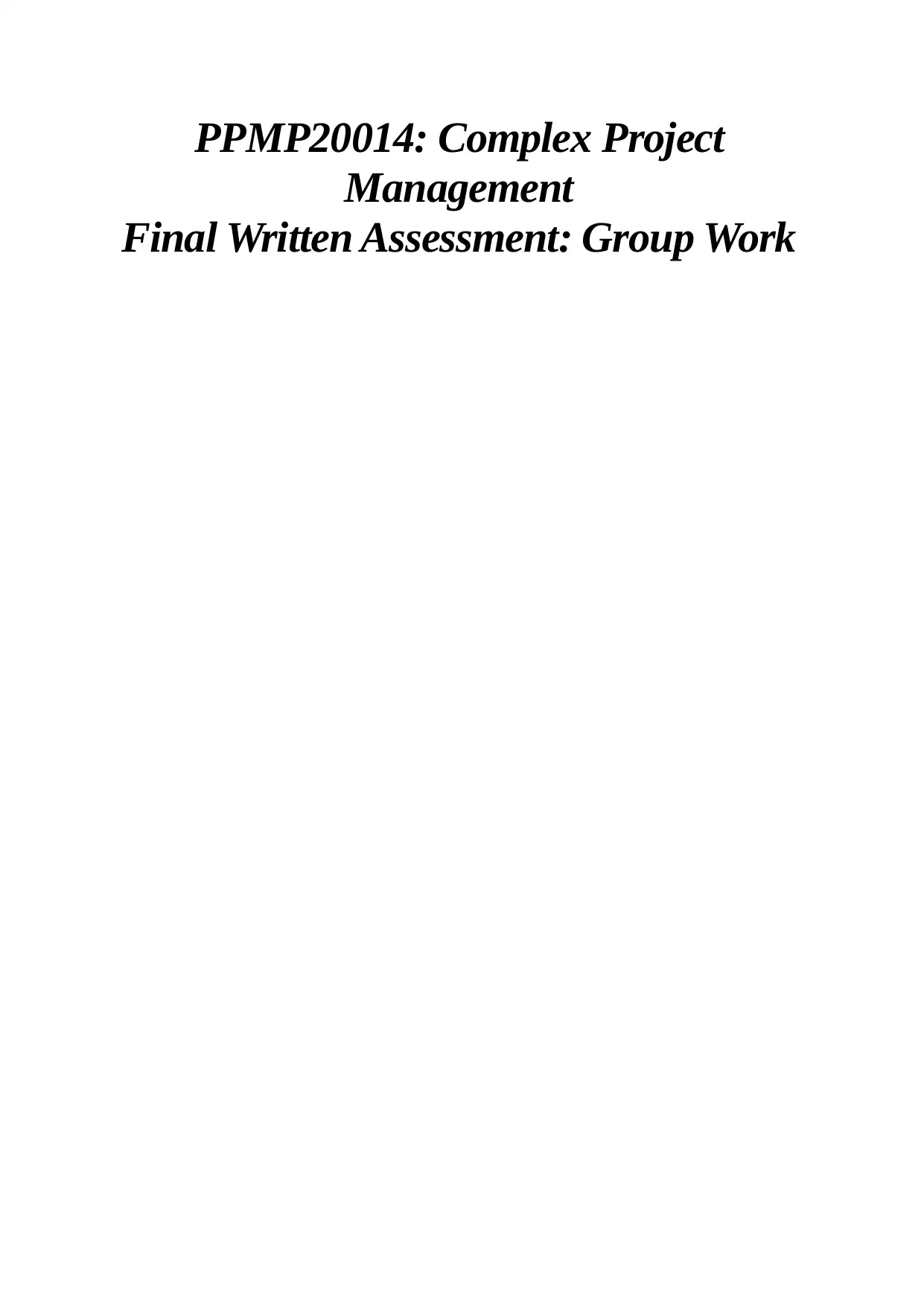
PPMP20014: Complex Project
Management
Final Written Assessment: Group Work
Management
Final Written Assessment: Group Work
Paraphrase This Document
Need a fresh take? Get an instant paraphrase of this document with our AI Paraphraser

TABLE OF CONTENTS
Abstract......................................................................................................................................4
Key words..................................................................................................................................5
Introduction................................................................................................................................6
Literature review........................................................................................................................6
Investigation of the context and the scope of Climate Change issue along with identifying
its characteristics as a wicked problem..................................................................................6
The scale of the problem........................................................................................................7
Management of Climate Change issues at present.................................................................8
Risk associated with the current management practices........................................................9
Main stakeholders involved in Climate Change issue.........................................................10
Surrounding factors contributing to the Climate Change complexity.................................11
Research Methodology.............................................................................................................12
Framework for conducting the work....................................................................................12
Explanation of the radar diagram and its utility in the research..........................................12
Manner of evaluation of the level of complexity using Delphi method..............................12
Manner of estimation of complexity level and ranking of factors contributing to the
Climate Change....................................................................................................................12
Contribution and support by peers.......................................................................................13
Findings and recommendations................................................................................................14
Investigation of level of complexity by using Delphi method.............................................14
Representative Stakeholder matrix by considering main stakeholders involved in Climate
Change issue.........................................................................................................................16
Diagram representing factors contributing to the Climate Change complexity...................17
Proposal for management tool.............................................................................................18
Framework for management of identified wicked problem.................................................19
Abstract......................................................................................................................................4
Key words..................................................................................................................................5
Introduction................................................................................................................................6
Literature review........................................................................................................................6
Investigation of the context and the scope of Climate Change issue along with identifying
its characteristics as a wicked problem..................................................................................6
The scale of the problem........................................................................................................7
Management of Climate Change issues at present.................................................................8
Risk associated with the current management practices........................................................9
Main stakeholders involved in Climate Change issue.........................................................10
Surrounding factors contributing to the Climate Change complexity.................................11
Research Methodology.............................................................................................................12
Framework for conducting the work....................................................................................12
Explanation of the radar diagram and its utility in the research..........................................12
Manner of evaluation of the level of complexity using Delphi method..............................12
Manner of estimation of complexity level and ranking of factors contributing to the
Climate Change....................................................................................................................12
Contribution and support by peers.......................................................................................13
Findings and recommendations................................................................................................14
Investigation of level of complexity by using Delphi method.............................................14
Representative Stakeholder matrix by considering main stakeholders involved in Climate
Change issue.........................................................................................................................16
Diagram representing factors contributing to the Climate Change complexity...................17
Proposal for management tool.............................................................................................18
Framework for management of identified wicked problem.................................................19

Conclusion and disccusions.....................................................................................................21
References................................................................................................................................22
References................................................................................................................................22
⊘ This is a preview!⊘
Do you want full access?
Subscribe today to unlock all pages.

Trusted by 1+ million students worldwide
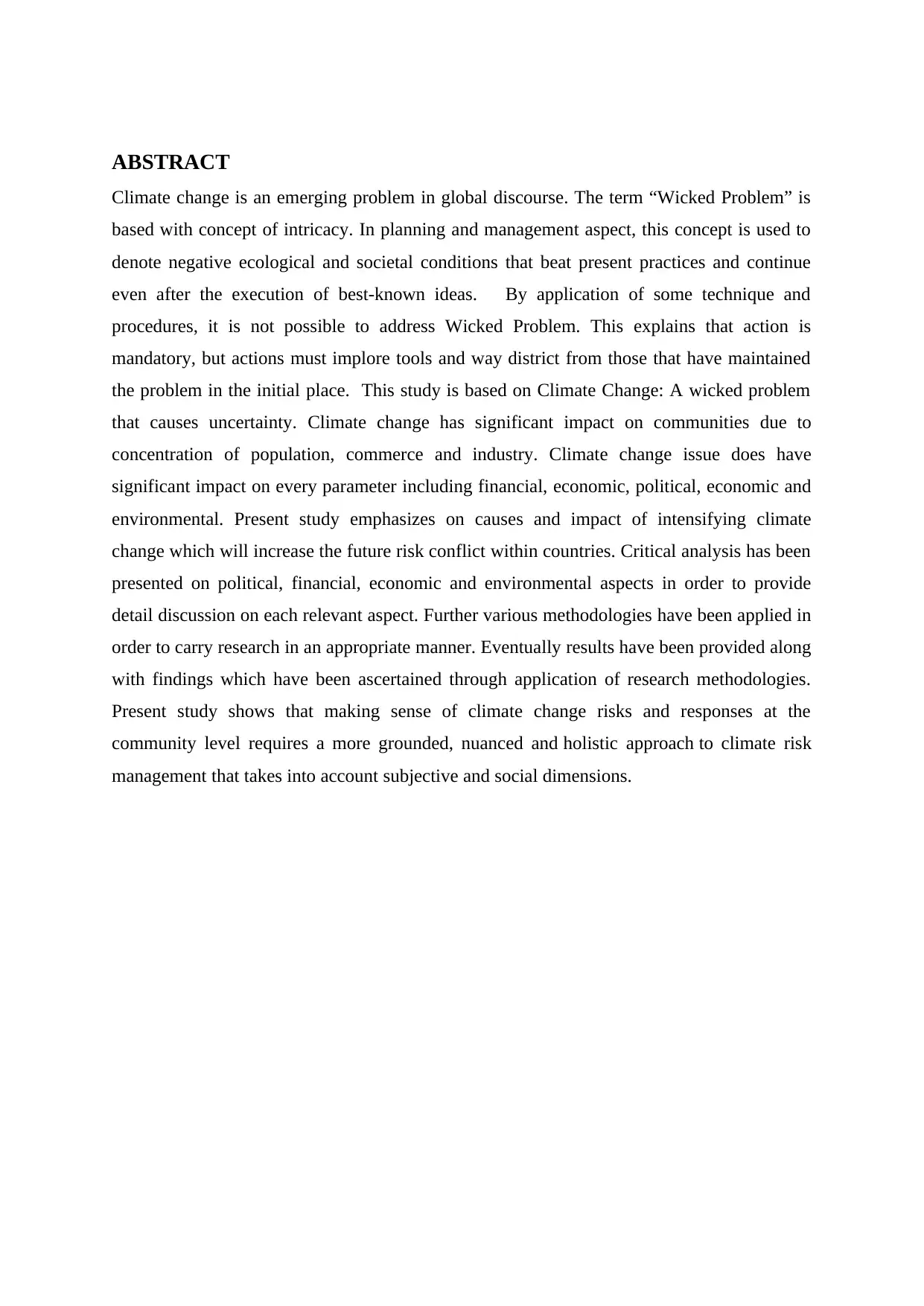
ABSTRACT
Climate change is an emerging problem in global discourse. The term “Wicked Problem” is
based with concept of intricacy. In planning and management aspect, this concept is used to
denote negative ecological and societal conditions that beat present practices and continue
even after the execution of best-known ideas. By application of some technique and
procedures, it is not possible to address Wicked Problem. This explains that action is
mandatory, but actions must implore tools and way district from those that have maintained
the problem in the initial place. This study is based on Climate Change: A wicked problem
that causes uncertainty. Climate change has significant impact on communities due to
concentration of population, commerce and industry. Climate change issue does have
significant impact on every parameter including financial, economic, political, economic and
environmental. Present study emphasizes on causes and impact of intensifying climate
change which will increase the future risk conflict within countries. Critical analysis has been
presented on political, financial, economic and environmental aspects in order to provide
detail discussion on each relevant aspect. Further various methodologies have been applied in
order to carry research in an appropriate manner. Eventually results have been provided along
with findings which have been ascertained through application of research methodologies.
Present study shows that making sense of climate change risks and responses at the
community level requires a more grounded, nuanced and holistic approach to climate risk
management that takes into account subjective and social dimensions.
Climate change is an emerging problem in global discourse. The term “Wicked Problem” is
based with concept of intricacy. In planning and management aspect, this concept is used to
denote negative ecological and societal conditions that beat present practices and continue
even after the execution of best-known ideas. By application of some technique and
procedures, it is not possible to address Wicked Problem. This explains that action is
mandatory, but actions must implore tools and way district from those that have maintained
the problem in the initial place. This study is based on Climate Change: A wicked problem
that causes uncertainty. Climate change has significant impact on communities due to
concentration of population, commerce and industry. Climate change issue does have
significant impact on every parameter including financial, economic, political, economic and
environmental. Present study emphasizes on causes and impact of intensifying climate
change which will increase the future risk conflict within countries. Critical analysis has been
presented on political, financial, economic and environmental aspects in order to provide
detail discussion on each relevant aspect. Further various methodologies have been applied in
order to carry research in an appropriate manner. Eventually results have been provided along
with findings which have been ascertained through application of research methodologies.
Present study shows that making sense of climate change risks and responses at the
community level requires a more grounded, nuanced and holistic approach to climate risk
management that takes into account subjective and social dimensions.
Paraphrase This Document
Need a fresh take? Get an instant paraphrase of this document with our AI Paraphraser
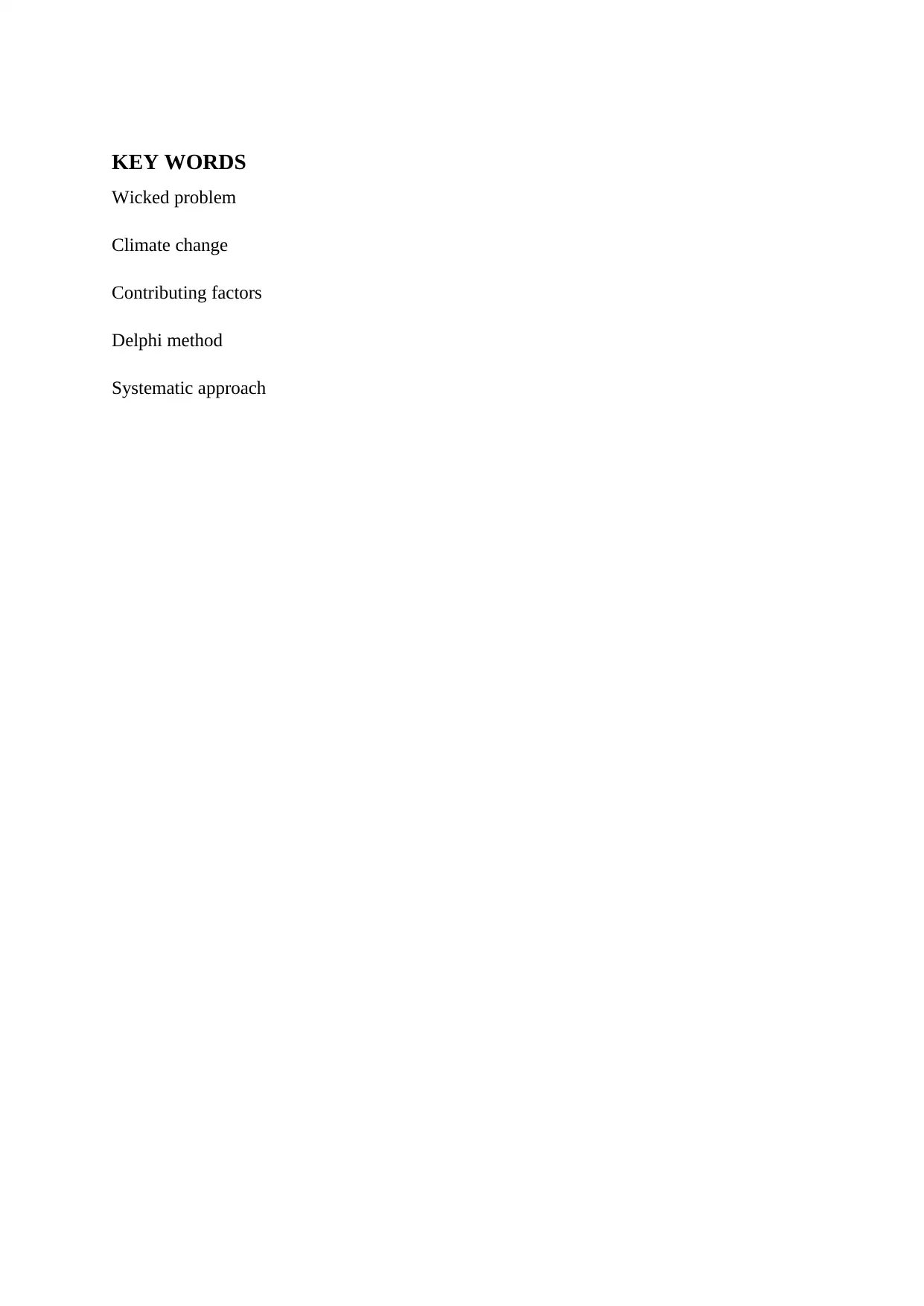
KEY WORDS
Wicked problem
Climate change
Contributing factors
Delphi method
Systematic approach
Wicked problem
Climate change
Contributing factors
Delphi method
Systematic approach
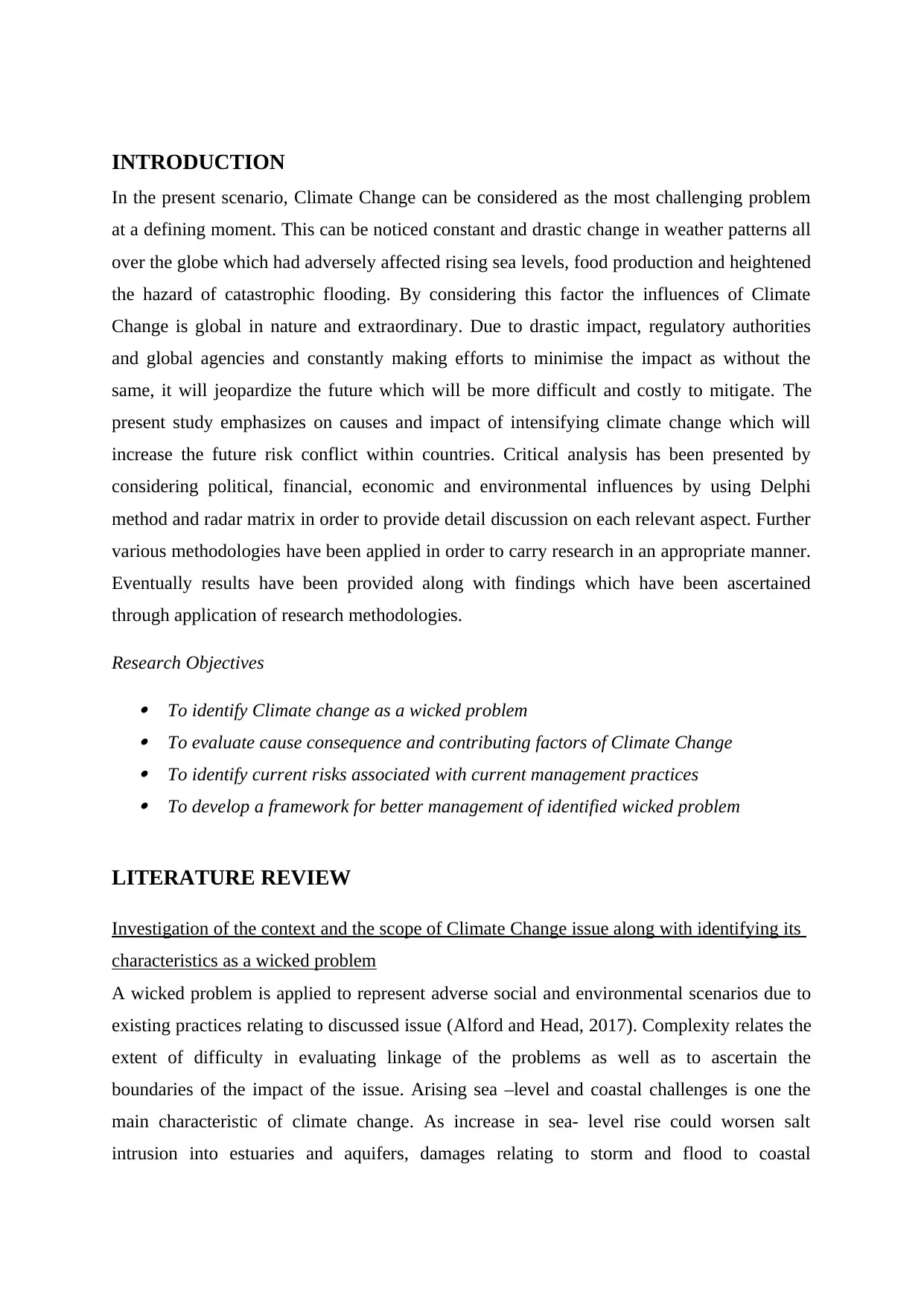
INTRODUCTION
In the present scenario, Climate Change can be considered as the most challenging problem
at a defining moment. This can be noticed constant and drastic change in weather patterns all
over the globe which had adversely affected rising sea levels, food production and heightened
the hazard of catastrophic flooding. By considering this factor the influences of Climate
Change is global in nature and extraordinary. Due to drastic impact, regulatory authorities
and global agencies and constantly making efforts to minimise the impact as without the
same, it will jeopardize the future which will be more difficult and costly to mitigate. The
present study emphasizes on causes and impact of intensifying climate change which will
increase the future risk conflict within countries. Critical analysis has been presented by
considering political, financial, economic and environmental influences by using Delphi
method and radar matrix in order to provide detail discussion on each relevant aspect. Further
various methodologies have been applied in order to carry research in an appropriate manner.
Eventually results have been provided along with findings which have been ascertained
through application of research methodologies.
Research Objectives
To identify Climate change as a wicked problem To evaluate cause consequence and contributing factors of Climate Change To identify current risks associated with current management practices To develop a framework for better management of identified wicked problem
LITERATURE REVIEW
Investigation of the context and the scope of Climate Change issue along with identifying its
characteristics as a wicked problem
A wicked problem is applied to represent adverse social and environmental scenarios due to
existing practices relating to discussed issue (Alford and Head, 2017). Complexity relates the
extent of difficulty in evaluating linkage of the problems as well as to ascertain the
boundaries of the impact of the issue. Arising sea –level and coastal challenges is one the
main characteristic of climate change. As increase in sea- level rise could worsen salt
intrusion into estuaries and aquifers, damages relating to storm and flood to coastal
In the present scenario, Climate Change can be considered as the most challenging problem
at a defining moment. This can be noticed constant and drastic change in weather patterns all
over the globe which had adversely affected rising sea levels, food production and heightened
the hazard of catastrophic flooding. By considering this factor the influences of Climate
Change is global in nature and extraordinary. Due to drastic impact, regulatory authorities
and global agencies and constantly making efforts to minimise the impact as without the
same, it will jeopardize the future which will be more difficult and costly to mitigate. The
present study emphasizes on causes and impact of intensifying climate change which will
increase the future risk conflict within countries. Critical analysis has been presented by
considering political, financial, economic and environmental influences by using Delphi
method and radar matrix in order to provide detail discussion on each relevant aspect. Further
various methodologies have been applied in order to carry research in an appropriate manner.
Eventually results have been provided along with findings which have been ascertained
through application of research methodologies.
Research Objectives
To identify Climate change as a wicked problem To evaluate cause consequence and contributing factors of Climate Change To identify current risks associated with current management practices To develop a framework for better management of identified wicked problem
LITERATURE REVIEW
Investigation of the context and the scope of Climate Change issue along with identifying its
characteristics as a wicked problem
A wicked problem is applied to represent adverse social and environmental scenarios due to
existing practices relating to discussed issue (Alford and Head, 2017). Complexity relates the
extent of difficulty in evaluating linkage of the problems as well as to ascertain the
boundaries of the impact of the issue. Arising sea –level and coastal challenges is one the
main characteristic of climate change. As increase in sea- level rise could worsen salt
intrusion into estuaries and aquifers, damages relating to storm and flood to coastal
⊘ This is a preview!⊘
Do you want full access?
Subscribe today to unlock all pages.

Trusted by 1+ million students worldwide

properties. There is no immediate or ultimate test through which solution of climate change
issues. Environmental issues which are attached to climate change comprise drought and
flood which result in water shortage through drying local rivers and disrupting water quality.
The specified issues negatively impact on human life in significant manner.
The issue of climate change in interlinked with political, economic variants as it affects the
decision making relating to climate change. Even technologist and planners are exploring an
effective solution for climate change in order to mitigate its impact. The unequal distribution
of impact of climate change has led towards unfairness on the poor people as they suffer most
on a comparative basis. Further it is directly linked to global warming may lead to significant
changes in climate extremes like heat waves, cyclone. It would destroy the infrastructure and
increase cost by significant energy demand, maintenance for distribution and transportation
infrastructure.
Climate change issues do fits in various sectors which mean that it affects various social and
economic perspectives. Due to same reason, it has resulted in a high complex issue which
requires to be addressed at multiple scales to attain appropriate solution.
Climate change has influenced financial mechanism through increasing financial flows in
climate change arena as public funds are growing in order to provide an incentive to resolve
climate change issues which comprise Pilot Program for Climate Resilience etc. It has also
impacted the organization of governance structure in developing countries in order to break
traditional donor –receipt relationship. Climate change issues have affected life of human
beings in significant manner as it has arisen issues such as global warming, temperature
increase etc. Further, warmer climate leads to impact water supplies, agriculture, human
health and ecosystem. It could be assessed that climate change issues do have significant
impact on various other issues, thus it is not possible to provide a single solution or to resolve
same. The specified characteristic complies with the definition of wicked problem. Thus, as
per above discussed specification and characteristics, it can be defined as a wicked issue.
The scale of the problem
Changes in climate create significant impact on the human community and natural system
across the world at large scale. It negatively creates an impact on community, environmental,
and political system of the country. Countries like Australia are significantly vulnerable to the
impact of climate change. It has enhanced hot climate, high rainfall, wildfire risk, and it also
leads to increase in wildfires. Further, tourism also affected by climate changes, which make
issues. Environmental issues which are attached to climate change comprise drought and
flood which result in water shortage through drying local rivers and disrupting water quality.
The specified issues negatively impact on human life in significant manner.
The issue of climate change in interlinked with political, economic variants as it affects the
decision making relating to climate change. Even technologist and planners are exploring an
effective solution for climate change in order to mitigate its impact. The unequal distribution
of impact of climate change has led towards unfairness on the poor people as they suffer most
on a comparative basis. Further it is directly linked to global warming may lead to significant
changes in climate extremes like heat waves, cyclone. It would destroy the infrastructure and
increase cost by significant energy demand, maintenance for distribution and transportation
infrastructure.
Climate change issues do fits in various sectors which mean that it affects various social and
economic perspectives. Due to same reason, it has resulted in a high complex issue which
requires to be addressed at multiple scales to attain appropriate solution.
Climate change has influenced financial mechanism through increasing financial flows in
climate change arena as public funds are growing in order to provide an incentive to resolve
climate change issues which comprise Pilot Program for Climate Resilience etc. It has also
impacted the organization of governance structure in developing countries in order to break
traditional donor –receipt relationship. Climate change issues have affected life of human
beings in significant manner as it has arisen issues such as global warming, temperature
increase etc. Further, warmer climate leads to impact water supplies, agriculture, human
health and ecosystem. It could be assessed that climate change issues do have significant
impact on various other issues, thus it is not possible to provide a single solution or to resolve
same. The specified characteristic complies with the definition of wicked problem. Thus, as
per above discussed specification and characteristics, it can be defined as a wicked issue.
The scale of the problem
Changes in climate create significant impact on the human community and natural system
across the world at large scale. It negatively creates an impact on community, environmental,
and political system of the country. Countries like Australia are significantly vulnerable to the
impact of climate change. It has enhanced hot climate, high rainfall, wildfire risk, and it also
leads to increase in wildfires. Further, tourism also affected by climate changes, which make
Paraphrase This Document
Need a fresh take? Get an instant paraphrase of this document with our AI Paraphraser

impact on revenue of government. It has been observed that climate change across the world
is very comprehensive and it is uncertain. The reasons for climate changes can be divided
into two parts, such as because of natural reasons, and due to human activities. There is
number of natural elements which lead to climate change. It includes continental float, sea
tides, volcanoes, slope of earth, and others (Urban, 2015). Evidence of this comes from, that
in the year 1991, Mount Pinatoba, in the Philippine islands exploded. It results in emission of
several gases into the environment. It assist in reduction of extent of solar radiation coming to
surface of earth, decreasing temperature in the lower level of environment, and ultimately
leads to altering movement pattern in environment (Causes of Climate Change, 2019).
Another aspect of climate change in related with human activities. Due to industrialization,
there is significant use of fossil fuels for running business activities (Gustavsson& et.al
2017). With this aspect, greenhouse gas emission, consumption of electricity, poor
management of waste, growing population are some factors that assist in climate change.
Due to climate change, there is significantly increased in the seal level that mainly impact on
two aspects such as melting of glaciers, and thermal extension of the hot water. For example,
between the years 1901 to 2010, there is rise in sea level by 1.7mm a year. On the other hand,
by considering the data of 1993 to 2013, the rate of increase was 3.2 mm per year (Causes of
climate change, 2019). Along with this, it also assists in warmness, draught, and wildfires.
For example, recently because of change in climate wildfire take place at Amazon forest.
Moreover, it also creates adverse impact on agriculture, livestock, health of human,
environment, infrastructure and many others. The government made several polices for
organizations to protect the environment, however still some companies does not comply
with rules and regulations. Along with this, conflicts and disagreement among individual
would also enhance by climate changes (Seidl, & et.al 2017). The impact of global warming
on the earth generally assists geographical alternation that intimidates to dislocate already
weak states such as Horn of Africa. The pressure on natural resources demoralizes the
capability of country to regulate them, and enhance the possibility of conflicts and
disagreement. Further, for reducing the impact of climate change, regulatory authorizes
changes policies, such as at present it is mandatory for companies to provide sustainable
report to user of financial statement, by this investor and general public get to know about
activities carried by companies for welfare of people.
is very comprehensive and it is uncertain. The reasons for climate changes can be divided
into two parts, such as because of natural reasons, and due to human activities. There is
number of natural elements which lead to climate change. It includes continental float, sea
tides, volcanoes, slope of earth, and others (Urban, 2015). Evidence of this comes from, that
in the year 1991, Mount Pinatoba, in the Philippine islands exploded. It results in emission of
several gases into the environment. It assist in reduction of extent of solar radiation coming to
surface of earth, decreasing temperature in the lower level of environment, and ultimately
leads to altering movement pattern in environment (Causes of Climate Change, 2019).
Another aspect of climate change in related with human activities. Due to industrialization,
there is significant use of fossil fuels for running business activities (Gustavsson& et.al
2017). With this aspect, greenhouse gas emission, consumption of electricity, poor
management of waste, growing population are some factors that assist in climate change.
Due to climate change, there is significantly increased in the seal level that mainly impact on
two aspects such as melting of glaciers, and thermal extension of the hot water. For example,
between the years 1901 to 2010, there is rise in sea level by 1.7mm a year. On the other hand,
by considering the data of 1993 to 2013, the rate of increase was 3.2 mm per year (Causes of
climate change, 2019). Along with this, it also assists in warmness, draught, and wildfires.
For example, recently because of change in climate wildfire take place at Amazon forest.
Moreover, it also creates adverse impact on agriculture, livestock, health of human,
environment, infrastructure and many others. The government made several polices for
organizations to protect the environment, however still some companies does not comply
with rules and regulations. Along with this, conflicts and disagreement among individual
would also enhance by climate changes (Seidl, & et.al 2017). The impact of global warming
on the earth generally assists geographical alternation that intimidates to dislocate already
weak states such as Horn of Africa. The pressure on natural resources demoralizes the
capability of country to regulate them, and enhance the possibility of conflicts and
disagreement. Further, for reducing the impact of climate change, regulatory authorizes
changes policies, such as at present it is mandatory for companies to provide sustainable
report to user of financial statement, by this investor and general public get to know about
activities carried by companies for welfare of people.
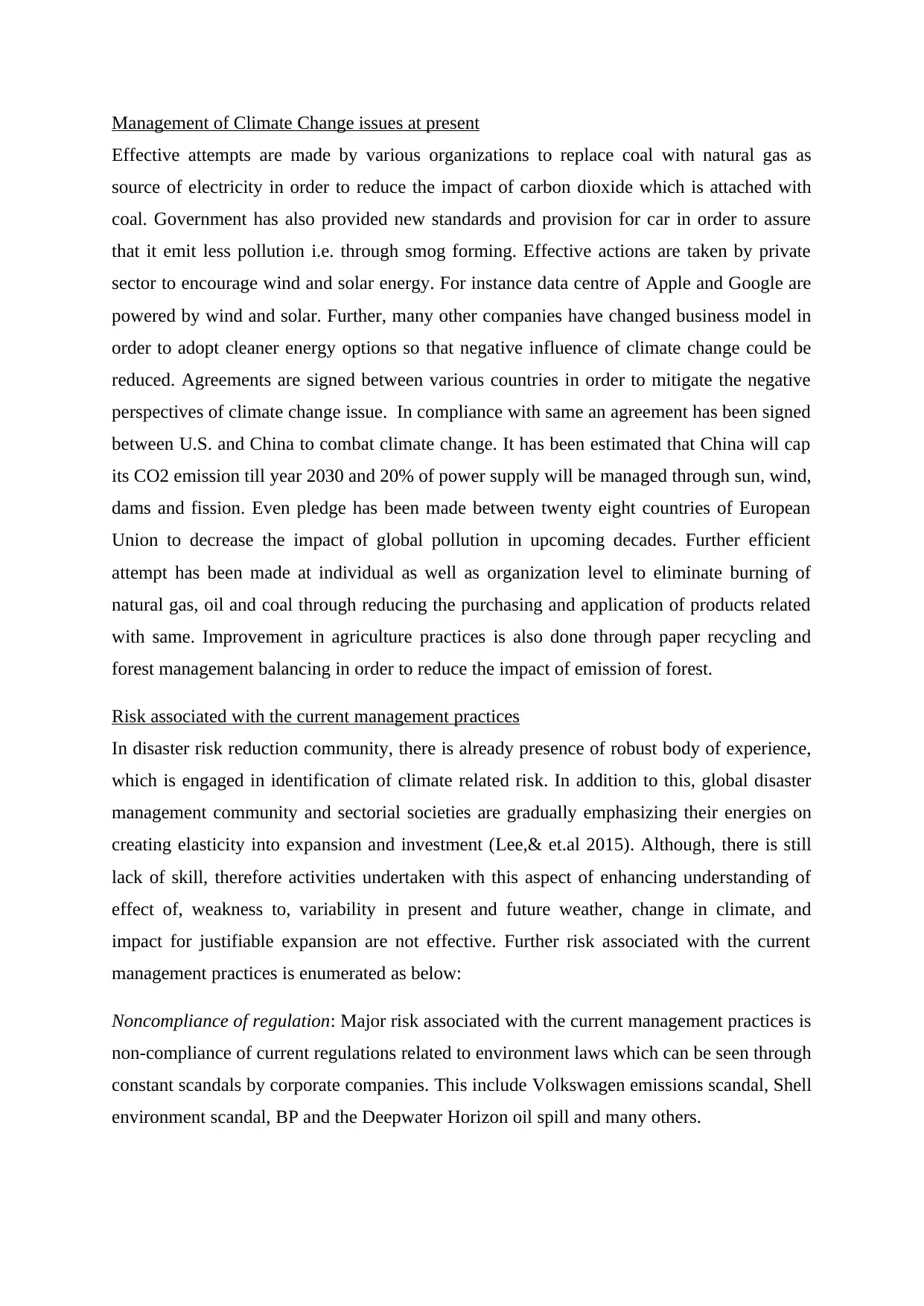
Management of Climate Change issues at present
Effective attempts are made by various organizations to replace coal with natural gas as
source of electricity in order to reduce the impact of carbon dioxide which is attached with
coal. Government has also provided new standards and provision for car in order to assure
that it emit less pollution i.e. through smog forming. Effective actions are taken by private
sector to encourage wind and solar energy. For instance data centre of Apple and Google are
powered by wind and solar. Further, many other companies have changed business model in
order to adopt cleaner energy options so that negative influence of climate change could be
reduced. Agreements are signed between various countries in order to mitigate the negative
perspectives of climate change issue. In compliance with same an agreement has been signed
between U.S. and China to combat climate change. It has been estimated that China will cap
its CO2 emission till year 2030 and 20% of power supply will be managed through sun, wind,
dams and fission. Even pledge has been made between twenty eight countries of European
Union to decrease the impact of global pollution in upcoming decades. Further efficient
attempt has been made at individual as well as organization level to eliminate burning of
natural gas, oil and coal through reducing the purchasing and application of products related
with same. Improvement in agriculture practices is also done through paper recycling and
forest management balancing in order to reduce the impact of emission of forest.
Risk associated with the current management practices
In disaster risk reduction community, there is already presence of robust body of experience,
which is engaged in identification of climate related risk. In addition to this, global disaster
management community and sectorial societies are gradually emphasizing their energies on
creating elasticity into expansion and investment (Lee,& et.al 2015). Although, there is still
lack of skill, therefore activities undertaken with this aspect of enhancing understanding of
effect of, weakness to, variability in present and future weather, change in climate, and
impact for justifiable expansion are not effective. Further risk associated with the current
management practices is enumerated as below:
Noncompliance of regulation: Major risk associated with the current management practices is
non-compliance of current regulations related to environment laws which can be seen through
constant scandals by corporate companies. This include Volkswagen emissions scandal, Shell
environment scandal, BP and the Deepwater Horizon oil spill and many others.
Effective attempts are made by various organizations to replace coal with natural gas as
source of electricity in order to reduce the impact of carbon dioxide which is attached with
coal. Government has also provided new standards and provision for car in order to assure
that it emit less pollution i.e. through smog forming. Effective actions are taken by private
sector to encourage wind and solar energy. For instance data centre of Apple and Google are
powered by wind and solar. Further, many other companies have changed business model in
order to adopt cleaner energy options so that negative influence of climate change could be
reduced. Agreements are signed between various countries in order to mitigate the negative
perspectives of climate change issue. In compliance with same an agreement has been signed
between U.S. and China to combat climate change. It has been estimated that China will cap
its CO2 emission till year 2030 and 20% of power supply will be managed through sun, wind,
dams and fission. Even pledge has been made between twenty eight countries of European
Union to decrease the impact of global pollution in upcoming decades. Further efficient
attempt has been made at individual as well as organization level to eliminate burning of
natural gas, oil and coal through reducing the purchasing and application of products related
with same. Improvement in agriculture practices is also done through paper recycling and
forest management balancing in order to reduce the impact of emission of forest.
Risk associated with the current management practices
In disaster risk reduction community, there is already presence of robust body of experience,
which is engaged in identification of climate related risk. In addition to this, global disaster
management community and sectorial societies are gradually emphasizing their energies on
creating elasticity into expansion and investment (Lee,& et.al 2015). Although, there is still
lack of skill, therefore activities undertaken with this aspect of enhancing understanding of
effect of, weakness to, variability in present and future weather, change in climate, and
impact for justifiable expansion are not effective. Further risk associated with the current
management practices is enumerated as below:
Noncompliance of regulation: Major risk associated with the current management practices is
non-compliance of current regulations related to environment laws which can be seen through
constant scandals by corporate companies. This include Volkswagen emissions scandal, Shell
environment scandal, BP and the Deepwater Horizon oil spill and many others.
⊘ This is a preview!⊘
Do you want full access?
Subscribe today to unlock all pages.

Trusted by 1+ million students worldwide
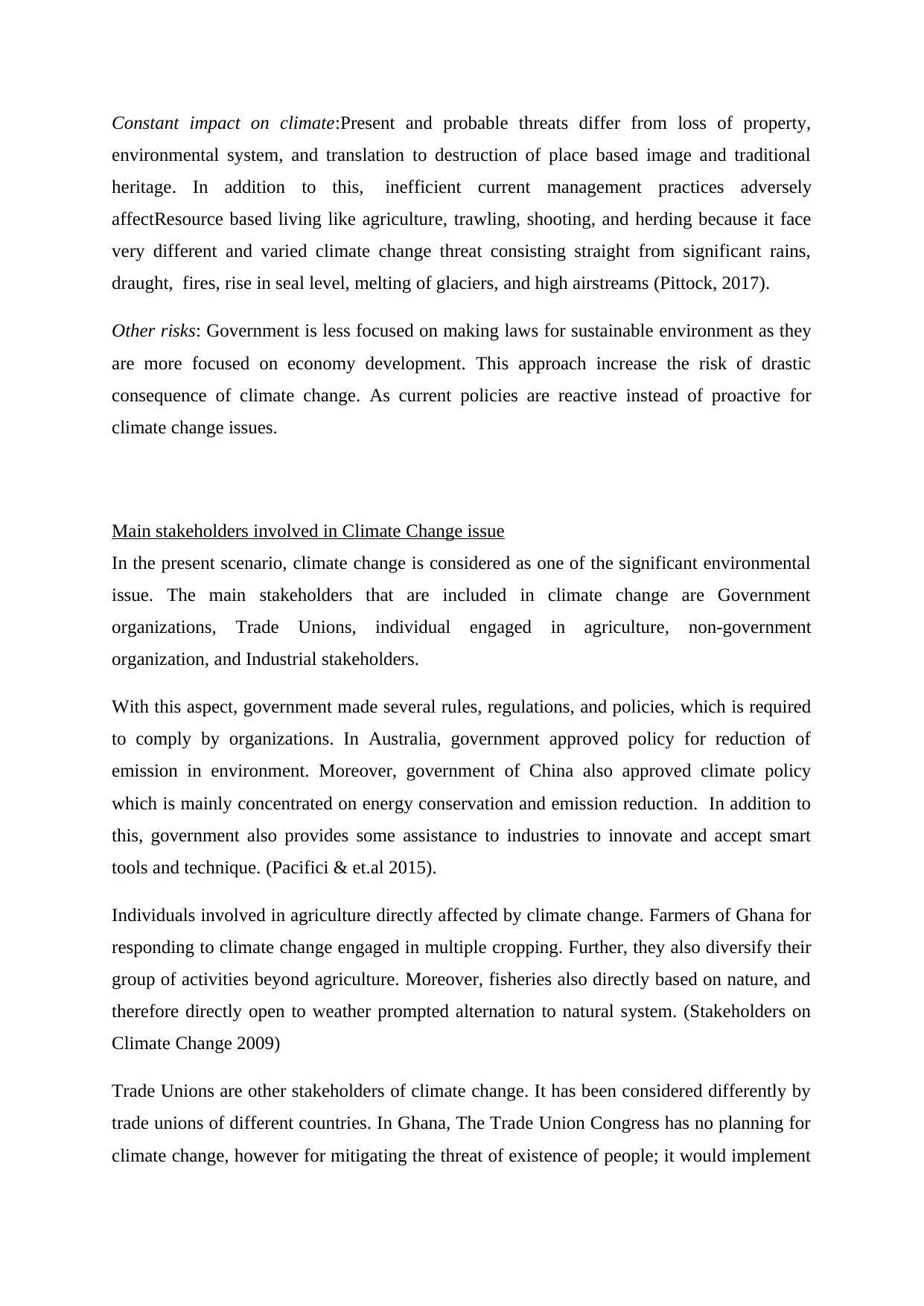
Constant impact on climate:Present and probable threats differ from loss of property,
environmental system, and translation to destruction of place based image and traditional
heritage. In addition to this, inefficient current management practices adversely
affectResource based living like agriculture, trawling, shooting, and herding because it face
very different and varied climate change threat consisting straight from significant rains,
draught, fires, rise in seal level, melting of glaciers, and high airstreams (Pittock, 2017).
Other risks: Government is less focused on making laws for sustainable environment as they
are more focused on economy development. This approach increase the risk of drastic
consequence of climate change. As current policies are reactive instead of proactive for
climate change issues.
Main stakeholders involved in Climate Change issue
In the present scenario, climate change is considered as one of the significant environmental
issue. The main stakeholders that are included in climate change are Government
organizations, Trade Unions, individual engaged in agriculture, non-government
organization, and Industrial stakeholders.
With this aspect, government made several rules, regulations, and policies, which is required
to comply by organizations. In Australia, government approved policy for reduction of
emission in environment. Moreover, government of China also approved climate policy
which is mainly concentrated on energy conservation and emission reduction. In addition to
this, government also provides some assistance to industries to innovate and accept smart
tools and technique. (Pacifici & et.al 2015).
Individuals involved in agriculture directly affected by climate change. Farmers of Ghana for
responding to climate change engaged in multiple cropping. Further, they also diversify their
group of activities beyond agriculture. Moreover, fisheries also directly based on nature, and
therefore directly open to weather prompted alternation to natural system. (Stakeholders on
Climate Change 2009)
Trade Unions are other stakeholders of climate change. It has been considered differently by
trade unions of different countries. In Ghana, The Trade Union Congress has no planning for
climate change, however for mitigating the threat of existence of people; it would implement
environmental system, and translation to destruction of place based image and traditional
heritage. In addition to this, inefficient current management practices adversely
affectResource based living like agriculture, trawling, shooting, and herding because it face
very different and varied climate change threat consisting straight from significant rains,
draught, fires, rise in seal level, melting of glaciers, and high airstreams (Pittock, 2017).
Other risks: Government is less focused on making laws for sustainable environment as they
are more focused on economy development. This approach increase the risk of drastic
consequence of climate change. As current policies are reactive instead of proactive for
climate change issues.
Main stakeholders involved in Climate Change issue
In the present scenario, climate change is considered as one of the significant environmental
issue. The main stakeholders that are included in climate change are Government
organizations, Trade Unions, individual engaged in agriculture, non-government
organization, and Industrial stakeholders.
With this aspect, government made several rules, regulations, and policies, which is required
to comply by organizations. In Australia, government approved policy for reduction of
emission in environment. Moreover, government of China also approved climate policy
which is mainly concentrated on energy conservation and emission reduction. In addition to
this, government also provides some assistance to industries to innovate and accept smart
tools and technique. (Pacifici & et.al 2015).
Individuals involved in agriculture directly affected by climate change. Farmers of Ghana for
responding to climate change engaged in multiple cropping. Further, they also diversify their
group of activities beyond agriculture. Moreover, fisheries also directly based on nature, and
therefore directly open to weather prompted alternation to natural system. (Stakeholders on
Climate Change 2009)
Trade Unions are other stakeholders of climate change. It has been considered differently by
trade unions of different countries. In Ghana, The Trade Union Congress has no planning for
climate change, however for mitigating the threat of existence of people; it would implement
Paraphrase This Document
Need a fresh take? Get an instant paraphrase of this document with our AI Paraphraser

some sustainable practices. Employees also affected by Due to the adverse impact on
environment by climate changes, therefore Trade Union plans to develop Environmental
Projection Agency (Stakeholders on Climate Change 2009).
Non-Governmental organisations have different roles and opportunities. They engaged in
increasing the public awareness regarding the climate change and environmental problem.
They come up with strategies that are effective in offering the actual incentive for the
majority of public to alter their behaviour.
Surrounding factors contributing to the Climate Change complexity
Effective implementation of developed policies and provision relating to climate change
could assist in decreasing the negative impact of climate change issues. However, the wicked
nature of issue has made in more complex for resolving or for attaining appropriate results
(Cook,& et.al 2016). Other practices which have contributed climate change complexities are
as follows:
Managed forests which play significant role in climate change are also referred as
socio-ecological system. However, it is difficult to assess the level of dispersion,
findings relating to carbon accounting inhabit and it makes the procedure of
developing managed forest complex (Slawinski,& et.al 2017).
Inappropriate use of land is making the situation more worsen. As when forest are
converted into agriculture lands, trees are removed which are main sources of
converting carbon dioxide into oxygen. The specified activity increases global
warming issues (Hornsey,& et.al 2016).
Human practices relating to conversion of forest into urban land have increased the
complexities as significance and importance of forest is not considered while taking
decision.
Conventional practices relating to development of societies and communities at areas
having risk from flood, raising sea level etc leads to unbalance the variants of
environment and disturbs ecological balance of nature.
Activities relating to burning of fossil fuels which releases carbon dioxide into the
atmosphere, eventually leads to cool or warm the climate system. Thus, it becomes
complex to stable the required temperature.
Different policies are followed by organization in order to mitigate the impact of
climate change. No standard policy which could be complied by all the organization
environment by climate changes, therefore Trade Union plans to develop Environmental
Projection Agency (Stakeholders on Climate Change 2009).
Non-Governmental organisations have different roles and opportunities. They engaged in
increasing the public awareness regarding the climate change and environmental problem.
They come up with strategies that are effective in offering the actual incentive for the
majority of public to alter their behaviour.
Surrounding factors contributing to the Climate Change complexity
Effective implementation of developed policies and provision relating to climate change
could assist in decreasing the negative impact of climate change issues. However, the wicked
nature of issue has made in more complex for resolving or for attaining appropriate results
(Cook,& et.al 2016). Other practices which have contributed climate change complexities are
as follows:
Managed forests which play significant role in climate change are also referred as
socio-ecological system. However, it is difficult to assess the level of dispersion,
findings relating to carbon accounting inhabit and it makes the procedure of
developing managed forest complex (Slawinski,& et.al 2017).
Inappropriate use of land is making the situation more worsen. As when forest are
converted into agriculture lands, trees are removed which are main sources of
converting carbon dioxide into oxygen. The specified activity increases global
warming issues (Hornsey,& et.al 2016).
Human practices relating to conversion of forest into urban land have increased the
complexities as significance and importance of forest is not considered while taking
decision.
Conventional practices relating to development of societies and communities at areas
having risk from flood, raising sea level etc leads to unbalance the variants of
environment and disturbs ecological balance of nature.
Activities relating to burning of fossil fuels which releases carbon dioxide into the
atmosphere, eventually leads to cool or warm the climate system. Thus, it becomes
complex to stable the required temperature.
Different policies are followed by organization in order to mitigate the impact of
climate change. No standard policy which could be complied by all the organization

is available. Thus, confusion exists that whether policies are to be followed on
mandatory basis or not. It could be stated that a complex framework is available as a
guide to reduce the negative impact of climate change.
RESEARCH METHODOLOGY
Framework for conducting the work
In order to assess the extent of complexity of climate change, it has been assessed from all
four perspectives i.e. political, financial, economical and environmental. Secondary research
method has been followed in order to assess previous examination of authors and researchers
relating to climate change. Further conclusions have also derived from scientific perspective
in order to analyse environmental impact due to intensified climate change. Impact of climate
change has been also assessed on economic activities in order to analyze its influence on
economic variants.
Explanation of the radar diagram and its utility in the research
A radar chart is the graphical technique of representation of multiple data. It is the manner of
two dimensional charts in which three or exceeding three numerical data depicted, which is
initiated from axis of same point. For observation of random number variable, this technique
is very appropriate. Every star signifies a single statement. Comprehensively, this chart is
initiated in a multi-plot manner with several stars on every page and every star signified one
statement.By using this chart, researcher will be able to represent factors contributing to the
Climate Change complexity and its comparative ranking (Nayyar,& et.al 2016).
Manner of evaluation of the level of complexity using Delphi method
For obtaining opinions or prediction by a panel of self-determining specialist above two or
more than two rounds, Delphi method is an appropriate and collaborating manner. This
technique does not need face to face interaction. It is implemented in the given study because
this technique assist to present broad picture of decision maker in generating opinion and
collaborating with stakeholders, as contrary to exclusively based on slight evidences
(Colagiuri, Boylan, and Morrice, 2015).
mandatory basis or not. It could be stated that a complex framework is available as a
guide to reduce the negative impact of climate change.
RESEARCH METHODOLOGY
Framework for conducting the work
In order to assess the extent of complexity of climate change, it has been assessed from all
four perspectives i.e. political, financial, economical and environmental. Secondary research
method has been followed in order to assess previous examination of authors and researchers
relating to climate change. Further conclusions have also derived from scientific perspective
in order to analyse environmental impact due to intensified climate change. Impact of climate
change has been also assessed on economic activities in order to analyze its influence on
economic variants.
Explanation of the radar diagram and its utility in the research
A radar chart is the graphical technique of representation of multiple data. It is the manner of
two dimensional charts in which three or exceeding three numerical data depicted, which is
initiated from axis of same point. For observation of random number variable, this technique
is very appropriate. Every star signifies a single statement. Comprehensively, this chart is
initiated in a multi-plot manner with several stars on every page and every star signified one
statement.By using this chart, researcher will be able to represent factors contributing to the
Climate Change complexity and its comparative ranking (Nayyar,& et.al 2016).
Manner of evaluation of the level of complexity using Delphi method
For obtaining opinions or prediction by a panel of self-determining specialist above two or
more than two rounds, Delphi method is an appropriate and collaborating manner. This
technique does not need face to face interaction. It is implemented in the given study because
this technique assist to present broad picture of decision maker in generating opinion and
collaborating with stakeholders, as contrary to exclusively based on slight evidences
(Colagiuri, Boylan, and Morrice, 2015).
⊘ This is a preview!⊘
Do you want full access?
Subscribe today to unlock all pages.

Trusted by 1+ million students worldwide
1 out of 24
Related Documents
Your All-in-One AI-Powered Toolkit for Academic Success.
+13062052269
info@desklib.com
Available 24*7 on WhatsApp / Email
![[object Object]](/_next/static/media/star-bottom.7253800d.svg)
Unlock your academic potential
Copyright © 2020–2025 A2Z Services. All Rights Reserved. Developed and managed by ZUCOL.



